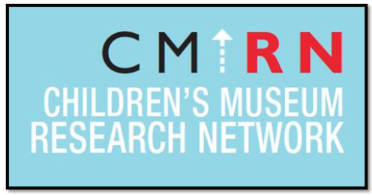The Children’s Museum Research Network (CMRN) was created in 2015 with funding from the U.S. Institute of Museum and Library Services. Its goal is to collectively develop a sustainable infrastructure for generating actionable, cross-institutional research results to advance the field-wide priorities established in the Learning Value of Children’s Museums Research Agenda.


The Association of Children's Museums and the University of Washington's Museology Graduate Program are partners in leading CMRN. An original cohort of ten children's museums was selected for their ongoing research and evaluation efforts. These ten museums have been instrumental in developing the Network and initiating research studies. An additional five museums joined the Network in September 2017. The participating institutions are:
Learn more about CMRN’s background and view an infographic about the project. CMRN has completed four research studies. Read more about the studies below.
The Network’s first study focused on learning frameworks with learning frameworks being defined as the educational standards and/or outcomes by which museums guide the development of exhibits and programs. The study analyzed learning frameworks from five Network museums. Analysis was guided by the following research questions:
The Network completed a document review of each of the five frameworks and interviews with key staff at the museums to develop a deeper understanding of how their institutional beliefs have been reflected in the learning frameworks’ development and use. Analysis of the data revealed three key themes: learning approaches, learning outcomes, and the role of play in each of the learning frameworks. Dissemination of the research study results include:
The Network’s first research study on Learning Frameworks revealed variation in how individual museums emphasize play, defined play, and described the connections between play and learning. For these reasons, the Network decided to focus on play for its second research study. The Network interviewed senior education and exhibits staff from a representative sample of 48 children’s museums across the U.S., asking each participant to describe their institution’s perspectives on play.
Research Question:
Interview Topics:
Study findings indicated that while many children’s museum staff strongly value play, few have formal descriptions of what play means or how play supports learning in their institutions. Dissemination of the research study results include:
Study findings indicated that most parents/caregivers did observe their child(ren) learning during their visit to a children’s museum and were able to identify different types of learning they observed. The study also revealed indications on the uniqueness of learning in a children’s museum. A follow-up interview was conducted in January 2018 in order to further understand the value of the observed learning to the parent/caregiver during their children’s museum visit. Dissemination of the research study results include:
The Network’s fourth research study is intended to provide a better understanding of how children’s museums contribute to the social and emotional growth of children. Observations of a child’s behavior were conducted at both children’s museums and “like” sites with free spaces designed for children’s play. Using an adapted version of the Minnesota Preschool Affect Checklist (MPAC) observation tool 468 observations of 4-5 year olds were conducted across 14 children’s museums, and 138 observations of 4-5 year olds at 12 “like” sites. 35 video-recorded observations were also conducted in children’s museums. The study is guided by the following:
The study findings indicate that children’s museum environments support more instances of a larger range of behaviors compared to “like” sites which support just one dominate behavior. These initial findings indicate that more complex social-emotional behaviors were observed in children’s museum environments. The Network is continuing to analyze the findings of this study. Dissemination of the research study results include: